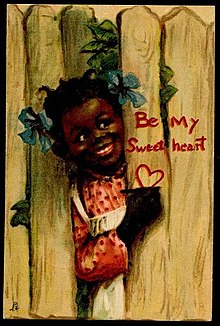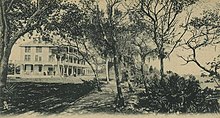Raphael Tuck & Sons
Raphael Tuck & Sons was an English postcard publisher for congratulatory and art postcards , as well as a manufacturer of chromolithographs , paper dolls , calendars and books.
The company founders
Raphael Tuch (* 1821 Koschmin near Breslau ; † 1900), who later called himself Raphael Tuck, was originally a carpenter. He lost all his possessions in the Austro-Prussian War and emigrated to England with his family in 1865, where he initially worked as a carpenter. In 1866 he opened a small workshop that sold framed pictures and chromolithographs , most of which were printed in Germany. In 1870 he and three of his then four sons - Hermann, Adolph (1854–1926) and Gustav - founded their own publishing house in London. Around 1881 Raphael Tuck retired and Adolph Tuck became managing director. Towards the end of the 19th century, Tuck & Sons were already allowed to call themselves purveyors to the court, and in 1910 Adolph Tuck was knighted for his services as a Knight Bachelor ("Sir").


The company and its products
The company flourished particularly in the Victorian era. In 1871 Raphael Tuck brought out his first Christmas postcard. For the fiftieth anniversary of Queen Victoria's reign , the series of pictures The Victoria Jubilee in 12 reliefs was published in 1887, illustrating some of the principal events during the 50 years of Her Most Gracious Queen Victoria ; a little later another series was published on the occasion of the coronation of Edward VII . In addition to series of pictures for such special occasions, Tuck & Sons mainly produced animal series. In addition, illustrated books were produced, often with moving parts or panorama functions.
The company, which had started out small, grew rapidly and eventually had branches in Paris, Berlin, Toronto and New York. In 1894 Adolph Tuck brought out his first postcard with a picture of Mount Snowdon , in 1898 the first series of postcards with 12 lithographs came out and the boom with postcards took off. In 1899 it was one of the first publishers to produce postcards in the 5.5 by 3.5 inch format . In 1900 the Tuck Company expanded into the USA. While the motifs were designed by American artists, the printing often took place in Germany, where the technique of chromolithography was in bloom. In 1904 around 15,000 picture postcard motifs were available. In 1929 Tuck also added clay postcards to its sales program. Since the glued-on small records largely obscured the image motif and, in the case of the surviving copies, no connection can be made between the image display and the addition of music, it can be assumed that Tuck used old stock of his map material that was difficult or impossible to sell for the sound postcards. The company had great success with its Oilette art postcard series , with reproductions of paintings on postcards, which were printed in particular in the JC König & Ebhardt business book factory in Hanover .
The A Father Tuck Little Books series can be seen as the forerunner of the Pixi books .
Raphael House in London was destroyed by an air raid on December 29, 1940, which resulted in the loss of numerous originals. In 1962 the company was sold to Purnell & Sons.
literature
- Children's Museum Boston, Raphael Tuck. Antique Paper Dolls in Full Color , Dover Pubn Inc. 1987, ISBN 0-486-25513-1
- JHD Smith, The Picture Postcards of Raphael Tuck & Sons , Colchester (IPM) 2000
- Blair Whitton, Collector's Guide to Raphael Tuck & Sons: Paper Dolls, Paper Toys & Children's Books , Hobby House Press 1991, ISBN 0-875-88370-2
Web links
Individual evidence
- ↑ a b The ABC of luxury paper , catalog for the exhibition of the Museum für Deutsche Volkskunde Berlin, page 64
- ↑ a b Raphael Tuck & Sons , accessed November 20, 2009
- ↑ a b Chromolithographs from Germany , website operator: Hans Hartung, accessed on November 20, 2009
- ↑ http://www.annatextiles.ch/publications/papier/papi.htm
- ↑ http://www.lotz-verlag.de/Phonokarten_Schalltrichter_teil2.pdf
- ↑ Archived copy ( Memento of the original from April 11, 2009 in the Internet Archive ) Info: The archive link was inserted automatically and has not yet been checked. Please check the original and archive link according to the instructions and then remove this notice.



